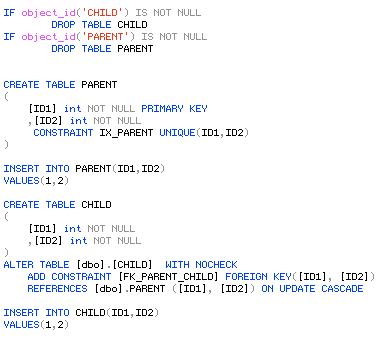Drop and Re-Create All Foreign Key Constraints in SQL Server
※ Download: Remove foreign key constraint
I hope it will solve your issue. Associated values in child table would be set to NULL. But the tricky part is that you can't drop the foreign key using the column name, but instead you would have to find the name used to index it.

I turned the code into a function so I could the function and return the 2 scripts for a specific table. The reportTo foreign key is also known as recursive or self-referencing foreign key. The statement has been terminated.

SQL Server Foreign Key Update and Delete Rules - Monday, July 02, 2018 - 1:29:24 PM - Paul This is a wonderful script..

However, in the referenced table, there must be an index where the referenced columns are listed as the first columns in the same order. This means that no user-partitioned InnoDB table may contain foreign key references or columns referenced by foreign keys. This is an InnoDB extension to standard SQL. For example, if you have defined a RESTRICT type constraint, and there is a child row with several parent rows, InnoDB does not permit the deletion of any of those parent rows. This means that you cannot use self-referential ON UPDATE CASCADE or ON UPDATE SET NULL operations. This is to prevent infinite loops resulting from cascaded updates. A self-referential ON DELETE SET NULL, on the other hand, is possible, as is a self-referential ON DELETE CASCADE. Cascading operations may not be nested more than 15 levels deep. When performing foreign key checks, InnoDB sets shared row-level locks on child or parent records it has to look at. InnoDB checks foreign key constraints immediately; the check is not deferred to transaction commit. According to the SQL standard, the default behavior should be deferred checking. That is, constraints are only checked after the entire SQL statement has been processed. Until InnoDB implements deferred constraint checking, some things are impossible, such as deleting a record that refers to itself using a foreign key. If you get an error: ERROR 1216: Cannot add or update a child row: a foreign key constraint fails it means you have two tables, at least one of which contains data, and you are trying to establish a relationship between keys such as table1. You can't force a relationship onto tables which are not already compliant with the constraint nor would you want to - if you are trying to do this, you haven't thought it out. In my case I had the parent table with int unsigned not null, and the child had int signed not null. So the signing was causing the error. I changed the child to be unsigned just a unwanted mistake on creating the table and all went fine. It's a known bug that is to be fixed in a later version.
I am currently testing. That was the old CODASYL network model. Select the CASCADE rule from the SSMS GUI as shown in the above screenshot or use this T-SQL code. Right now that is a tough pill to swallow. Sometimes, the child and parent tables are the same. Notice that if you use ON DELETE NO ACTION or ON DELETE RESTRICT action, MySQL will reject the deletion. The ON UPDATE NO ACTION or UPDATE RESTRICT actions reject any updates. CASCADE option Now let's change the default specification No Action to Cascade. HeaderId INNER JOIN dbo. Let's create the foreign key with the default specification through T-SQL.



